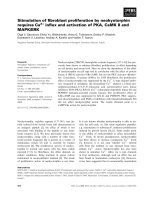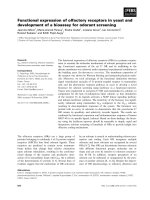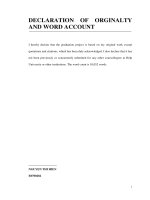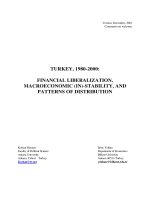Symmetry in mathematics and mathematics of symmetry
Bạn đang xem bản rút gọn của tài liệu. Xem và tải ngay bản đầy đủ của tài liệu tại đây (774.58 KB, 97 trang )
Symmetry in mathematics and mathematics of
symmetry
Peter J. Cameron
International Symmetry Conference, Edinburgh
January 2007
Symmetry in mathematics
Whatever you have to do with a
structure-endowed entity Σ try to
determine its group of
automorphisms . . . You can expect
to gain a deep insight into the
constitution of Σ in this way.
Hermann Weyl, Symmetry.
Symmetry in mathematics
Whatever you have to do with a
structure-endowed entity Σ try to
determine its group of
automorphisms . . . You can expect
to gain a deep insight into the
constitution of Σ in this way.
Hermann Weyl, Symmetry.
I begin with three classical examples, one from geometry, one
from model theory, and one from graph theory, to show the
contribution of symmetry to mathematics.
Example 1: Projective planes
A projective plane is a geometry of points and lines in which
two points lie on a unique line;
two lines meet in a unique point;
there exist four points, no three collinear.
Example 1: Projective planes
A projective plane is a geometry of points and lines in which
two points lie on a unique line;
two lines meet in a unique point;
there exist four points, no three collinear.
Hilbert showed:
Theorem
A projective plane can be coordinatised by a skew field if and only if it
satisfies Desargues’ Theorem.
Desargues’ Theorem
O
✡✄✄❉
✡✄ ❉
✡ ✄ ❉
❉
C1
✡
B1 ✏✏✄
❉
✏
❏
✡ ✄
✏✏✡ ◗
◗ ❏ ❉
✏
◗
✄ ◗❏ ❉
✏✏
✡
✏✏
✄
✏
◗❏❉ A1
✏
✡
◗
✄
✏✏
❉❏ ◗
✏
✡
✏
✄
❉ ❏◗
✏✏
✡
✏
✄
✏
❉ ❏Q ◗✥
✏
◗
✡
P ❳❳❳
✄
✥✥✥ R
❉✧✧
✥
❳❳ ❳
✡
✥
✥
✄ ✥✥ ✧ A2
❳❳
✡
❳❳❳
✥✥✄✥ ✧✧
✥
✥
✥
❳❳✡
✥
✄ ✧✧
B2❳❳❳❳
❳✧
✄
C2
How not to prove Hilbert’s Theorem
Set up coordinates in the projective plane, and define addition
and multiplication by geometric constructions.
Then prove that, if Desargues’ Theorem is valid, then the
coordinatising system satisfies the axioms for a skew field.
This is rather laborious! Even the simplest axioms require
multiple applications of Desargues’ Theorem.
How to prove Hilbert’s Theorem
A central collineation of a projective plane is one which fixes
every point on a line L (the axis) and every line through a point
O (the centre).
How to prove Hilbert’s Theorem
A central collineation of a projective plane is one which fixes
every point on a line L (the axis) and every line through a point
O (the centre).
Desargues’ Theorem is equivalent to the assertion:
Let O be a point and L a line of a projective plane. Choose
any line M = L passing through O. Then the group of
central collineations with centre O and axis L acts sharply
transitively on M \ {O, L ∩ M}.
How to prove Hilbert’s Theorem
A central collineation of a projective plane is one which fixes
every point on a line L (the axis) and every line through a point
O (the centre).
Desargues’ Theorem is equivalent to the assertion:
Let O be a point and L a line of a projective plane. Choose
any line M = L passing through O. Then the group of
central collineations with centre O and axis L acts sharply
transitively on M \ {O, L ∩ M}.
Now the additive group of the coordinatising skew field is the
group of central collineations with centre O and axis L where
O ∈ L; the multiplicative group is the group of central
collineations where O ∈
/ L.
So all we have to do is prove the distributive laws
(geometrically) and the commutative law of addition (which
follows easily from the other axioms).
Example 2: Categorical structures
A first-order language has symbols for variables, constants,
relations, functions, connectives and quantifiers. A structure M
over such a language consists of a set with given constants,
relations, and functions interpreting the symbols in the
language. It is a model for a set Σ of sentences if every sentence
in Σ is valid in M.
Example 2: Categorical structures
A first-order language has symbols for variables, constants,
relations, functions, connectives and quantifiers. A structure M
over such a language consists of a set with given constants,
relations, and functions interpreting the symbols in the
language. It is a model for a set Σ of sentences if every sentence
in Σ is valid in M.
A set Σ is categorical in power α (an infinite cardinal) if any two
models of Σ of cardinality α are isomorphic. Morley showed
that a set of sentences over a countable language which is
categorical in some uncountable power is categorical in all.
Example 2: Categorical structures
A first-order language has symbols for variables, constants,
relations, functions, connectives and quantifiers. A structure M
over such a language consists of a set with given constants,
relations, and functions interpreting the symbols in the
language. It is a model for a set Σ of sentences if every sentence
in Σ is valid in M.
A set Σ is categorical in power α (an infinite cardinal) if any two
models of Σ of cardinality α are isomorphic. Morley showed
that a set of sentences over a countable language which is
categorical in some uncountable power is categorical in all.
So there are only two types of categoricity: countable and
uncountable.
Oligomorphic permutation groups
Let G be a permutation group on a set Ω. We say that G is
oligomorphic if it has only a finite number of orbits on the set
Ωn for all natural numbers n.
Oligomorphic permutation groups
Let G be a permutation group on a set Ω. We say that G is
oligomorphic if it has only a finite number of orbits on the set
Ωn for all natural numbers n.
Example
Let G be the group of order-preserving permutations of the set
Q of rational numbers. Two n-tuples a and b of rationals lie in
the same G-orbit if and only if they satisfy the same equality
and order relations, that is,
ai = aj ⇔ bi = bj ,
ai < aj ⇔ bi < bj .
Oligomorphic permutation groups
Let G be a permutation group on a set Ω. We say that G is
oligomorphic if it has only a finite number of orbits on the set
Ωn for all natural numbers n.
Example
Let G be the group of order-preserving permutations of the set
Q of rational numbers. Two n-tuples a and b of rationals lie in
the same G-orbit if and only if they satisfy the same equality
and order relations, that is,
ai = aj ⇔ bi = bj ,
ai < aj ⇔ bi < bj .
So the number of orbits of G on Qn is equal to the number of
preorders on an n-set.
The theorem of Engeler, Ryll-Nardzewski and Svenonius
Axiomatisability is equivalent to symmetry!
The theorem of Engeler, Ryll-Nardzewski and Svenonius
Axiomatisability is equivalent to symmetry!
Theorem
Let M be a countable first-order structure. Then the theory of M is
countably categorical if and only if the automorphism group Aut(M)
is oligomorphic.
The theorem of Engeler, Ryll-Nardzewski and Svenonius
Axiomatisability is equivalent to symmetry!
Theorem
Let M be a countable first-order structure. Then the theory of M is
countably categorical if and only if the automorphism group Aut(M)
is oligomorphic.
Example
Cantor showed that Q is the unique countable dense linearly
ordered set without endpoints. So Q (as ordered set) is
countably categorical.
We saw that Aut(Q) is oligomorphic.
Oligomorphic groups and counting
The proof of the E–RN–S theorem shows that the number of
orbits of Aut(M) on Mn is equal to the number of n-types in the
theory of M.
Oligomorphic groups and counting
The proof of the E–RN–S theorem shows that the number of
orbits of Aut(M) on Mn is equal to the number of n-types in the
theory of M.
The counting sequences associated with oligomorphic groups
often coincide with important combinatorial sequences.
Oligomorphic groups and counting
The proof of the E–RN–S theorem shows that the number of
orbits of Aut(M) on Mn is equal to the number of n-types in the
theory of M.
The counting sequences associated with oligomorphic groups
often coincide with important combinatorial sequences.
A number of general properties of such sequences are known.
To state the next results, we let G be a permutation group on Ω;
let Fn (G) be the number of orbits of G on ordered n-tuples of
distinct elements of Ω, and fn (G) the number of orbits on
n-element subsets of Ω.
Oligomorphic groups and counting
The proof of the E–RN–S theorem shows that the number of
orbits of Aut(M) on Mn is equal to the number of n-types in the
theory of M.
The counting sequences associated with oligomorphic groups
often coincide with important combinatorial sequences.
A number of general properties of such sequences are known.
To state the next results, we let G be a permutation group on Ω;
let Fn (G) be the number of orbits of G on ordered n-tuples of
distinct elements of Ω, and fn (G) the number of orbits on
n-element subsets of Ω.
Typically, Fn (G) counts labelled combinatorial structures and
fn (G) counts unlabelled structures. Both sequences are
non-decreasing.
Sequences from oligomorphic groups
Theorem
There exists an absolute constant c such that, if G is an oligomorphic
permutation group on Ω which is primitive (i.e. preserves no
non-trivial partition of Ω), then either
fn (G) = 1 for all n; or
fn (G) ≥ cn /p(n) and Fn (G) ≥ n! cn /q(n), where p and q are
polynomials.
Sequences from oligomorphic groups
Theorem
There exists an absolute constant c such that, if G is an oligomorphic
permutation group on Ω which is primitive (i.e. preserves no
non-trivial partition of Ω), then either
fn (G) = 1 for all n; or
fn (G) ≥ cn /p(n) and Fn (G) ≥ n! cn /q(n), where p and q are
polynomials.
Merola gave c = 1.324 . . . . No examples are known with c < 2.









